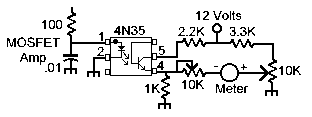





|
An optoisolator is substituted for one of the LED's in the 455 IF strip to provide an S-meter. Two optoisolators that have worked very well are the 4N25 and the 4N35. The 4N25 gives greater response than the 4N35 because it responds at a lower
threshold. They all use the same pin connections. Others will work, so if you have any in your junk box, try them out. You can scrounge them off old modem boards. You can recognize them by their 6 pin layout and most of their part numbers start with
"4N" or "6N".
I have found that any meter from 500 microamp sensitivity on down will work in this circuit. Surplus CB radio meters work great. Adjusting the S-meter is simple. Ground the AGC line on the IF strip, then adjust the full scale variable resistor for full scale reading on the meter. With the antenna disconnected, adjust the zero variable resistor for zero reading on the meter. The controls interact, so you may need to go back and forth to get it set right. Trying to maximize sensitivity of the optoisolator has been attempted by various means. One method, trying to put circuitry on the base, was studied and the following information from the Motorola Optoelectronics Device Data book (DL118/D, REV 4), Applications Note AN-508, "Applications of Phototransistors in Electro-Optic Systems", page 11-25, was found concerning this method. "Mention is often made of the ability to optimize a phototransistor's sensitivity by using the base. The idea is that the device can be electrically biased to a collector current at which hFE is maximum. However, the introduction of any impedance into the base results in a net decrease in photo sensitivity. This is similar to the effect noticed when Iceo is measured for a transistor and found to be greater than Icer. The base-emitter resistor shunts some current around the base-emitter junction, and the shunted current is never multiplied by hFE. "Now when the phototransistor is biased to peak hFE, the magnitude of base impedance is low enough to shunt an appreciable amount of photo current around the base-emitter. The result is actually a lower device sensitivity than found in the open base mode." |
Return to: Amateur Radio Receivers ||
LED Mosfet Receiver
|| Send E-Mail
